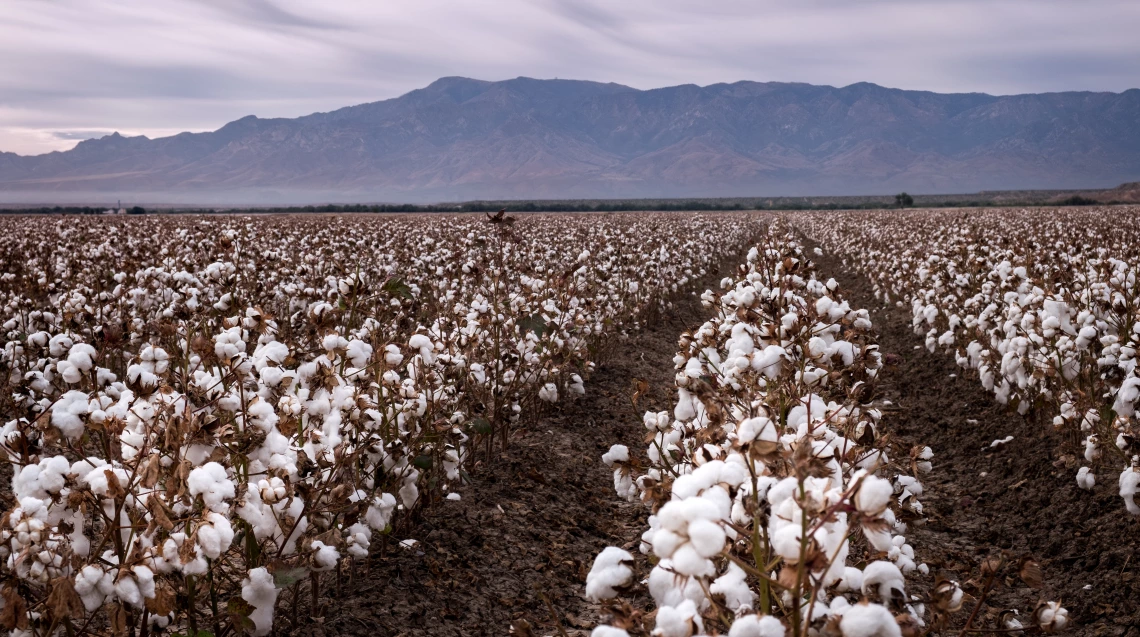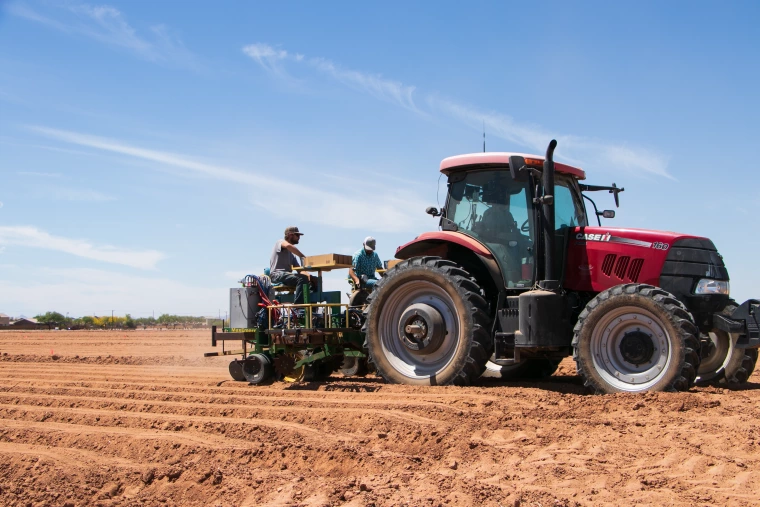Why do we grow cotton in Arizona?
Cotton is a famously thirsty crop, yet Arizona is one of the top U.S. producers. But how does a crop that thrives on water and humidity manage to flourish in one of the driest corners of the U.S.? The answer might surprise you.

AdobeStock_231256524
Arizona’s cotton industry generates $322 million in total sales and drives nearly 1,500 jobs across the state—this according to the latest data from the USDA Census of Agriculture compiled in a recent study from economic analysts with the University of Arizona Cooperative Extension.
Cotton has long been one of Arizona’s 5 C’s—alongside copper, cattle, citrus, and climate—shaping the state’s economy and identity. But how does a crop that craves water thrive in one of the driest places in the U.S.?
The answer lies in Arizona’s rich agricultural history, where innovation, tenacity and resilience have allowed farmers to overcome the odds. For decades, they’ve adapted cutting-edge technology, developed water-saving techniques, and relied on generations of passed-down knowledge to make cotton a success in the desert.
Let’s break down how this seemingly improbable crop became not just a staple of Arizona’s economy, but a key player in the global cotton market.
Cotton’s ancient desert beginnings

Research laboratory for cotton and wool technology in the Agriculture Building, University of Arizona, 1929.
University of Arizona Special Collections
Cotton has been part of Arizona's history for centuries. The Sonoran Desert, which stretches across southern Arizona and northern Sonora, Mexico, is home to Gossypium thurberi, a wild cotton plant.
Thousands of years ago, the Hohokam people in southern Arizona were already growing and irrigating cotton, with evidence of its cultivation dating back to A.D. 500–1200.
“Ancient caches of cottonseed found in the Gila River Valley suggest that the Hohokam practiced irrigated agriculture, cultivating cotton for weaving and possibly trade,” said Jeff Silvertooth, a University of Arizona professor in the department of Environmental Science and Extension Specialist in agronomy.
By the late 1800s, the U.S. Department of Agriculture (USDA) began identifying crops that could help support Arizona’s growing economy—crops that could handle Arizona’s extreme heat, soil salinity and water scarcity.
“Cotton – along with wheat, barley, and alfalfa – was identified as a good candidate for the region,” Silvertooth explained.
With the right irrigation, cotton showed great promise. But the real game-changer came in 1906, when a group of USDA agronomists traveled to Egypt to learn more about the country’s long-staple variety, prized for its fine, long fibers. With seeds in hand, they returned to the U.S. and began testing them in the Arizona desert near Sacaton and Yuma.
The variety thrived in the territory’s desert, and Pima cotton—prized for its silky, strong, long fibers—was born.
Arizona’s cotton-ready climate: Why the heat helps
While most crops suffer in extreme heat, cotton actually thrives. Cotton plants love hot, dry weather—and Arizona delivers that in spades.
“The combination of hot summer days and relatively cool nights creates an optimal environment for cotton production,” explained Randy Norton, Director of the Safford Agricultural Center and an agronomist with the U of A Cooperative Extension.
And as it turns out, Arizona’s dry climate doesn’t just help cotton grow—it helps it grow better. In humid regions, cotton is more prone to pests, mildew and plant diseases that thrive in moisture, often requiring chemical treatments to keep them in check. But in Arizona, the dry air acts as a natural defense, keeping plants healthier with less intervention.
The lack of late-season rain is another surprising bonus. Cotton lint is especially vulnerable to water damage when the bolls open near harvest time in the fall. Too much moisture can weaken fibers or reduce their quality. But Arizona’s reliably dry fall weather helps protect those bolls, leading to cleaner, stronger, and more uniform fiber—a big deal for markets that demand consistent quality.
Arizona also plays a key role in the industry’s seed production. Our dry climate makes it ideal for producing high-quality planting seed used across 17 southern states stretching from Virginia to California—an area famously known as the "Cotton Belt."
“In fact, as much as 70% of Arizona’s cotton acreage is contracted for seed production,” Norton says.
The science of cotton: Genetics, irrigation, and resilience

Staff at the Maricopa Agricultural Center planting cotton, May 2025. In Arizona, cotton is planted in late Spring (April-May) and harvested in the fall (October-November).
Luis Zozaya, U of A College of Agriculture, Life & Environmental Sciences
Cotton farming in Arizona supports a network of research and innovation. Every year, the U of A Cooperative Extension conducts large-scale variety testing at Arizona Experiment Station sites in Safford, Maricopa and Yuma—working with growers, seed companies and industry groups to help farmers select the right varieties for changing conditions.
“Variety selection is one of the most important decisions a grower makes,” Norton explains. “With advances in genetics and pest management traits, it’s gotten more complex—and that’s why this testing program is so valuable.”
Arizona might not seem like the most obvious place for cotton. But from a crop per drop performance perspective, it makes a whole lot of sense.
With the help of agricultural researchers, farmers have developed and adopted a range of water-efficient irrigation techniques, such as drip irrigation and laser leveling, which minimize waste and ensure every drop counts, according to Silvertooth. Some growers even use soil moisture sensors and satellite technology to guide precisely when and how much to irrigate.
“In terms of water use, cotton is a relatively efficient crop compared to many others that could be grown in Arizona’s arid climate,” said Norton.
To put this in perspective:
- In 1984, Arizona cotton growers applied 4.9 acre-feet (AF) of irrigation water per acre with a yield of 242 pounds of cotton lint per AF applied, according to George Frisvold, an agricultural and natural resource economist at the U of A.
- By 2023, growers averaged 4.2 AF of water applied per acre and a yield of 299 pounds of cotton lint per AF applied.
“This represents a 23% increase in the amount of cotton produced per AF of water applied,” Frisvold said.
In addition to these water savings, Arizona cotton farmers have made impressive strides in reducing pesticide use. The introduction of Bt cotton in 1995, a genetically modified variety resistant to certain pests like the pink bollworm, was a game-changer for the industry. Bt cotton significantly reduced the need for chemical pesticides, allowing farmers to use fewer applications and reduce their environmental impact.
From the mid-1990s to 2023, Arizona cotton growers:
- Reduced pesticide use from 9 applications per acre to just 0.58 applications.
- Lowered pesticide application costs from $244 per acre to $17.51.
In fact, Arizona’s 0.58 pesticide applications per acre is the lowest among cotton-producing states—less than one-fifth of the U.S. national average of 3.2 applications, according to Frisvold.
The future of Arizona cotton (and why we should care)
Despite all its advantages, growing cotton in the desert isn’t a passive process. It’s the result of decades of science, strategy and technological innovation.
As the state faces long-term drought and tightening water allocations, some farmers are shifting away from cotton. But those who stick with the crop are doing so with intention—and innovation. They’re growing with the desert, adapting to new technologies and environmental realities.
Globally, cotton thrives within a defined latitudinal zone, roughly between 30° north and 30° south of the equator, Silvertooth explained. Some cultivation can extend slightly beyond this range, reaching as far as 45° north and 35° south. This band includes key cotton-producing countries like China, India, Pakistan and Brazil. But there’s a clear sweet spot, according to Silvertooth: long, hot summers with ample water during the growing season and dry conditions at harvest.
Arizona cultivates two major types of cotton: Upland (Gossypium hirsutum) and Pima (Gossypium barbadense). Arizona ranks among the top three producers of Pima cotton in the United States (in terms of cotton production in bales). Pinal County is in the top 1% of all U.S. counties, while Graham County is in the top 10% of U.S. counties in terms of cotton and cottonseed sales. Yuma and Maricopa counties are in the top quarter in sales, while Pima County is in the top third, nationally.
“At its peak in the 1980s, nearly 500,000 acres statewide were planted with cotton,” Norton explained. “Today, that number has dropped to around 100,000 acres, with about 20% devoted to Pima. Still, cotton remains a critical part of the state’s rural economy.”
Simply put: Being able to grow cotton domestically offers both geographic and economic advantages. The cotton we grow in Arizona supports rural economies, bolsters the U.S. textile supply chain, and reduces our reliance on imports.
